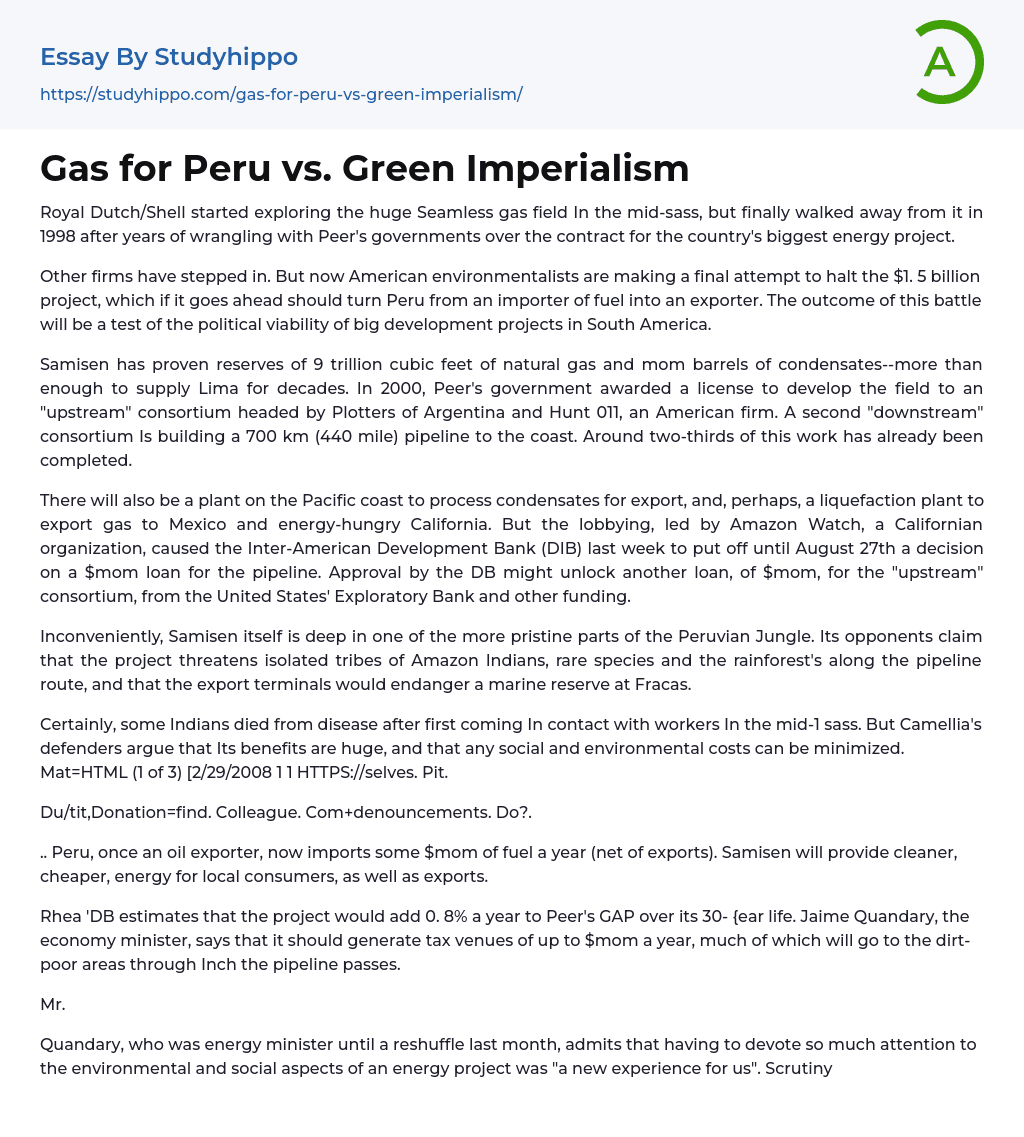Royal Dutch/Shell started exploring the huge Seamless gas field In the mid-sass, but finally walked away from it in 1998 after years of wrangling with Peer's governments over the contract for the country's biggest energy project.
Other firms have stepped in. But now American environmentalists are making a final attempt to halt the $1. 5 billion project, which if it goes ahead should turn Peru from an importer of fuel into an exporter. The outcome of this battle will be a test of the political viability of big development projects in South America.
Samisen has proven reserves of 9 trillion cubic feet of natural gas and mom barrels of condensates--more than enough to supply Lima for decades. In 2000, Peer's government awarded a license to develop the field to an "upstream" consortium headed by Plotters of Argentina a
...nd Hunt 011, an American firm. A second "downstream" consortium Is building a 700 km (440 mile) pipeline to the coast. Around two-thirds of this work has already been completed.
There will also be a plant on the Pacific coast to process condensates for export, and, perhaps, a liquefaction plant to export gas to Mexico and energy-hungry California. But the lobbying, led by Amazon Watch, a Californian organization, caused the Inter-American Development Bank (DIB) last week to put off until August 27th a decision on a $mom loan for the pipeline. Approval by the DB might unlock another loan, of $mom, for the "upstream" consortium, from the United States' Exploratory Bank and other funding.
Inconveniently, Samisen itself is deep in one of the more pristine parts of the Peruvian Jungle. Its opponents claim that the project threaten
isolated tribes of Amazon Indians, rare species and the rainforest's along the pipeline route, and that the export terminals would endanger a marine reserve at Fracas.
Certainly, some Indians died from disease after first coming In contact with workers In the mid-1 sass. But Camellia's defenders argue that Its benefits are huge, and that any social and environmental costs can be minimized. Mat=HTML (1 of 3) [2/29/2008 1 1 HTTPS://selves. Pit.
Du/tit,Donation=find. Colleague. Com+denouncements. Do?.
.. Peru, once an oil exporter, now imports some $mom of fuel a year (net of exports). Samisen will provide cleaner, cheaper, energy for local consumers, as well as exports.
Rhea 'DB estimates that the project would add 0. 8% a year to Peer's GAP over its 30- {ear life. Jaime Quandary, the economy minister, says that it should generate tax venues of up to $mom a year, much of which will go to the dirt-poor areas through Inch the pipeline passes.
Mr.
Quandary, who was energy minister until a reshuffle last month, admits that having to devote so much attention to the environmental and social aspects of an energy project was "a new experience for us". Scrutiny by greens has forced the government and the developers to take some desirable precautions. The consortium is using "offshore" technology at Samisen: drilling sites are being operated as if they Nerve islands in the Jungle. Workers and supplies are helicopter in.
There are no access roads. Jungle will soon cover over the scars left by construction work. He 'DB insists that its involvement has already led to improvements in the project design. Over the past year, it has carried out detailed environmental and
social- impact studies. It has also given Peru a $mm "institution-building" loan to help it police the Samisen project, and proposes to finance parallel monitoring by local groups. Peer's government has also been doing its best to show that it is aware of the risks.
Partly at the urging of the 'DB and others, it has strengthened legal protection or the Indian reserves near Samisen and set up a special ombudsman to monitor the whole project.
The energy regulator recently fined the pipeline consortium for a breach of environmental regulations. None of this mollifies the more radical American greens, such as Amazon Watch. They claim massive soil erosion is taking place along the pipeline route (something which can and should be remedied).
They also oppose the planned location of the export terminals. These are close to the Fracas marine reserve (not within it, as they imply), but in an area already disfigured y fishmeal plants and a smelter.
In a sign that the lobbying has more to do with American domestic politics than with the interests of Peruvians, Amazon Watch has told Journalists that the Samisen loans would "enrich some of Mr. Bush's closest corporate campaign contributors".
Britain's Independent newspaper plastered this allegation across its front page last week. The chairman of Hunt Oil is indeed a friend of Mr. Bush. But though Hallucination, named as another "beneficiary", has done a feasibility study for the liquefaction plant, it has no involvement in Samisen itself.
- Energy Development essays
- The elements essays
- Voltage essays
- Solar Energy essays
- Nuclear Energy essays
- Alternative Energy essays
- Atom essays
- Big Bang Theory essays
- Density essays
- Electricity essays
- Energy essays
- Force essays
- Heat essays
- Light essays
- Motion essays
- Nuclear Power essays
- Physiology essays
- Sound essays
- Speed essays
- Temperature essays
- Thermodynamics essays
- Cuban Missile Crisis essays
- Fidel Castro essays
- French Revolution essays
- Han Dynasty essays
- Hiroshima essays
- Imperialism essays
- Jack The Ripper essays
- Mao Zedong essays
- Middle Ages essays
- Mongols essays
- Nelson Mandela essays
- Ottoman Empire essays
- Reformation essays
- Reign of Terror essays
- Renaissance essays
- Roaring Twenties essays
- Romanticism essays
- Samurai essays
- Scientific Revolution essays
- Soviet Union essays




